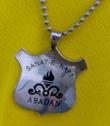اینم یک نرم افزار عالی برای اینکه کامپیوتر خودتون رو به یک اسپکتورم آنالایزر تمام عیار تبدیل کنید...

مشخصات نرم افزار :
Frequency Range: up to 96 KHz (depending on Sound Card)
Bandwidth: 10 Hz - 96 kHz (depending on Sound Card)
Maximum Allowable Input Voltage (if connected directly): about 2 VAC (depending on Sound Card)
Selectable sampling frequency (up to 192 kHz), sampling bit resolution (8, 16 or 24 bits) and sampling channels (one or two) (all depending on Sound Card)
Four triggering modes: no trigger, repeated trigger, single trigger and slow trigger
Support triggering by leading edge or trailing edge at specified triggering level and on selected input channel
Support pre-triggering and post triggering from 0 to 100% of the selected record length
Continuously monitor the input signal such that no trigger event is missed before data collection
Can be used as a transient signal recorder to capture and store data for up to 500 s
Four view types: Real time amplitude spectrum display, Real time phase spectrum display, Real time auto correlation display, Real time cross correlation display
Independent X axis and Y axis zooming and scrolling
In amplitude spectrum display, Y axis supports relative display modes in linear and dBr scale, and absolute display mode in RMS voltage, dBV and dBu scale. X axis supports linear, logarithmic, octave, 1/3 octave, 1/6 octave, 1/12 octave and 1/24 octave scale
WAV file can be imported for display and analysis
Collected measurement data can be saved as WAV file or exported as TXT file
Data curve can be printed out directly or saved as BMP file
Support calibration of the input channels for different gain settings
Support adding notes to the measurement data
Fast display refresh rate: about 50 frames per second (tested under Windows XP SP2 on IBM ThinkPad R51 Laptop PC with Intel (R) Pentium (R) M processor 1.60 GHz, with scan time=10 ms and FFT size=1024 and both Oscilloscope and Spectrum Analyzer running under "no trigger" mode). Thus data are displayed and analyzed in "true" real time
The colors of display are configurable
Number of points to be collected per scan can be fine tuned at one point"s resolution
FFT size can be adjusted from 128 to 32768 points
Allow record length to be different from FFT size. If the FFT size is greater than the record length, then zero will be added at the end of the actual measurement data during FFT computation. If the FFT size is less than the record length, then the measurement data will be split into different segments with the size of each segment equal to the FFT size. The final result will be obtained by averaging the FFT results from all segments
Support windowing functions: Rectangle, Triangle, Hanning, Hamming and Blackman
Display the peak frequency, Total Harmonic Distortion (THD), THD+Noise (THD+N), Signal in Noise and Distortion (SINAD), Signal-to-Noise Ratio (SNR) and cross correlation peak location and correlation coefficient
Support one cursor reader and two markers which stick to the measurement data
Options are provided to remove the DC component during spectrum analysis
Three inter-frame processing methods: None, Peak Hold, Averaging
Five chart types: Line, Scatter, Column, Bar, and Step
Support Multilingual User Interface under Windows 2000, XP, 2003 and above. Currently supported languages are English, French, German, Italian, Portuguese, Spanish, Simplified Chinese, Traditional Chinese, Japanese and Korean. Support only the local language and English under Window 95, 98, Me and Windows NT
دانلود:
Download
توضیحات مربوط به ساخت کابل ورودی و خروجی :
Typically, the "MIC" socket of a sound card has an input impedance of 1500 Ω ~ 20 kΩ (card dependent) and requires a minimum input signal level of at least 10 mV. It only allows a single channel input.
The "Line In" socket of a sound card has an input impedance typically around 10 kΩ ~ 47 kΩ (card dependent), and the input signal level of this connection is in the range of 500 mV ~ 2 V (card dependent). Generally, the "Line In" should be used as the primary input connection for Oscilloscope and Spectrum Analyzer as it offers better Signal-to-Noise Ratio (SNR) and bandwidth.
The "Line Out" connection of a sound card has an output impedance typically in the range of 20 Ω ~ 500 Ω (card dependent) and can output signal up to 2 V typically (card dependent). It has better SNR than the "Speaker" connection.
The "Speaker" connection of a sound card has a typical output impedance of 8 Ω (card dependent) and output power of 2 W (card dependent).
For input connection, the simplest way is to directly connect the signal under test to the sound card "Line In" or "MIC" socket (see the figure below). However, this kind of connection requires the tester to be extremely careful to ensure the input signal is within the acceptable range before connecting. Otherwise the sound card or even the PC may get burn.
The following figure shows the output connection for Signal Generator. The resister is used to prevent the possible short circuit of the output. It can be omitted if you are careful enough. As the output impedance of a sound card is very low, there should not be any impedance matching problem when connected to external circuit.
منبع : http://www.ir-micro.com











